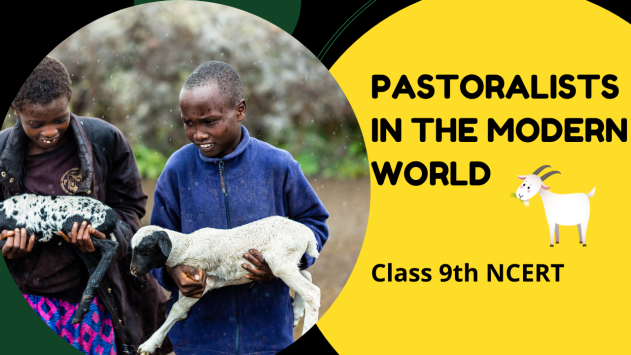We are providing you short notes of Pastoralists in the modern world class 9th along with the NCERT solutions. Students can get their concepts clear after they go through and easily solve the back exercises. It will help to analyze their level of preparation. NCERT Solutions can clear their doubts related to how to write good answers.
Short notes and that too of Social Science will help you to learn the basic concepts of each and every chapter and know how to write answers in the examination. Pastoralists In The Modern World Class 9th Social Science is an important chapter in Social Science and it holds very important terms.
So, notes will help the students to get the gist of the lesson and we have also shared the Pastoralists In The Modern World Class 9th Social Science Map Work to get you to know the location points of Nomadic Groups.
Pastoralists in the Modern World Class 9th
Pastoral Nomads and their Movements
In the Mountains
In the nineteenth century, Gujjar Bakarwals of Jammu and Kashmir migrated to the mountains in search of pastures for their animals. During the winter, they moved to the low hills of the Siwalik range. By the end of April, they began to march for their summer grazing grounds. This journey is known as a kafila. Again, they started their march by the end of September, this time back to their winter base. The Gaddi shepherds of Himachal Pradesh follow the same cycle.
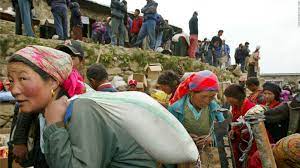
This pattern of cyclic movements can be seen in many communities of the Himalayas, including sherpas, and Bhotiyas.
On the Plateaus, Plains, and Deserts
Pastoralists can be found in plains, mountains, and even in the plateaus of India. In Maharashtra, one can see Dhangars who are basically shepherds, blanket weavers, etc. who stay at the central plateau during monsoon. After harvesting bajra in the month of October they move to the west. In the state of Karnataka and Andhra Pradesh, where the plateau is generally covered with stone and grass, these were called Gollas herded cattle.
Raikas lived in the deserts of Rajasthan and during monsoons, they stayed in their villages, where pasture was available. By October, they moved out in search of other pastures. Pastoral lives are not very easy and for their sustenance, they had to calculate the timing of movements and ensure that they could move through different areas. They also set up relationships with farmers in order to graze fields and manure the soil.

Colonial Rule and Pastoral Life
Under colonial rule, pastoralists’ movements were controlled and regulated, grazing grounds were reduced and revenue had to be paid in large amounts. It all happened due to the following reasons:
- Land revenue was one of the main sources of finance for the colonial state. So, the colonial government wanted to transform all grazing lands into cultivated farms through which they could expand cultivation and increase their revenue collection. All uncultivated land was seen as ‘wasteland’.
- Various acts were enacted during the colonial period. According to these Acts, forests that produced commercially valuable timber like deodar or sal were declared ‘Reserved’ and other forests were classified as ‘Protected’. These Forest Acts changed the lives of pastoralists as they were prevented from entering many forests.
- British officials were suspicious of nomadic people. The colonial government wanted to rule over a settled population. In 1871, the colonial government in India passed the Criminal Tribes Act. By this Act, many communities of craftsmen, traders, and pastoralists were classified as Criminal Tribes. They were stated to be criminals by nature and birth.
- Taxation was imposed on land, canal water, salt, trade goods, and even on animals. In most pastoral tracts of India, a grazing tax was introduced in the mid-nineteenth century. In the decades between the 1850s and 1880s, the right to collect the tax was auctioned out to contractors. By the 1880s the government began collecting taxes directly from the pastoralists.
How Did These Changes Affect the Lives of Pastoralists?
Due to these measures, there was a shortage of pastures. When grazing lands were taken over and turned into cultivated fields, the available area of pastureland declined. As pasturelands disappeared under the plow, the existing animal stock had to feed on whatever grazing land remained. When restrictions were imposed on pastoral movements, grazing lands came to be continuously used and the quality of pastures declined. This, in turn, created a further shortage of forage for animals and the deterioration of animal stock.
How Did the Pastoralists Cope with these Changes?
Pastoralists reacted to these changes in various ways:
- No. of cattle was reduced and after the partition herding of sheep and camels was also stopped on the banks of the river Indus.
- Over the years, some richer pastoralists bought land and settled down, giving up their nomadic life. Some became peasants by cultivating land, others indulged in trading. On the other hand, poor pastoralists borrowed money from moneylenders to survive.
- They still continued to survive and in many regions, their numbers have expanded. In many other parts of the world, new laws and settlement patterns forced pastoral communities to alter their lives.
Pastoralism in Africa
In Africa, even today, over 22 million Africans depend on some form of pastoral activity for their livelihood. Like pastoralists in India, the lives of African pastoralists have changed dramatically over the colonial and post-colonial periods.
Where have the Grazing Lands Gone?
Before colonial times, Maasailand stretched over a vast area from north Kenya to the steppes of northern Tanzania. In 1885, it was cut into half with an international boundary between British Kenya and German Tanganyika. After the cut, the best grazing lands were gradually taken over for white settlement and the Maasai were pushed into a small area in southern Kenya and northern Tanzania.

From the late nineteenth century, the British colonial government in east Africa encouraged local peasant communities to expand cultivation. In pre-colonial times, the Maasai pastoralists dominated their agricultural neighbors both economically and politically. The loss of the finest grazing lands and water resources created pressure on the small area of land that the Maasai were confined within.
The Borders are Closed
In the nineteenth century, African pastoralists could move over vast areas in search of pastures. But, from the late nineteenth century, the colonial government began imposing various restrictions on their mobility. White settlers and European colonists saw pastoralists as dangerous and savage. The new territorial boundaries and restrictions imposed on them suddenly changed the lives of pastoralists, which adversely affected both their pastoral and trading activities.
When Pastures Dry
Pastoralists’ lives were affected by drought everywhere. That is why, traditionally, pastoralists move from place to place to survive bad times and avoid crises. But from the colonial period, the Maasai were bound down to a fixed area, confined within a reserve, and prohibited from moving in search of pastures. As the area of grazing lands shrank, the adverse effect of the droughts increased in intensity.
Not All were Equally Affected
In Maasailand, not all pastoralists were equally affected by the changes in the colonial period. In pre-colonial times Maasai society was divided into two social categories – elders and warriors. The elders formed the ruling group and met in periodic councils to decide on the affairs of the community and settle disputes. The warriors consisted of younger people, mainly responsible for the protection of the tribe and defending the community, and organized cattle raids.
The British introduced a series of measures that had important implications, to administer the affairs of the Maasai. They appointed chiefs of different sub-groups of Maasai, who were made responsible for the affairs of the tribe. Restrictions were also imposed on raiding and warfare. These chiefs managed to survive the devastations of war and drought.
But the life history of the poor pastoralists was different. In times of war and famine, they lost nearly everything. They had to go looking for work in the towns. Some used to work as charcoal burners, and some did odd jobs to earn their living.
The social changes in Maasai society occurred at two levels. First, the traditional difference based on age, between the elders and warriors, was disturbed, though it did not break down entirely. Second, a new distinction between the wealthy and poor pastoralists developed.
Pastoralists in the Modern World Class 9th: NCERT Solutions
Question 1. Explain why nomadic tribes need to move from one place to another. What are the advantages to the environment of this continuous movement?
Nomads are people who do not live in one place but move from one area to another to earn their living. These people are involved in animal husbandry and move in search of green pastures for their cattle.
It is suited to many hilly and dry regions of the world. They also have set relations with the farmers so that they could graze and harvest in the fields and manure the soil easily.
Question 2. Discuss why the colonial government in India brought in the following laws. In each case, explain how the law changed the lives of pastoralists:
– Waste Land rules
– Forest Acts
– Criminal Tribes Act
– Grazing Tax
1. Waste Land rules
Waste Land Rules were enacted in various parts of the country and after this rule land was taken away and given to selected individuals. These were also granted concessions and encouraged for having settled farms. Some of them were also made the headmen. In most areas, the lands taken over were grazing tracts used regularly by pastoralists. So the expansion of cultivation inevitably meant the decline of pastures and a problem for pastoralists.
2. Forest Acts
After the enactment of various forest acts in different provinces some forests were declared reserved and no one was allowed to enter these forests. These acts changed their lives and now their movements are controlled and regulated. They needed a permit to enter.
The timing of their entry and departure was specified, and the number of days they could spend in the forest Source was limited.
3. Criminal Tribes Act
Once this Act came into force, these communities were expected to live only in notified village settlements. They were not allowed to move out without a permit. The village police kept a continuous eye on them.
4. Grazing Tax
The colonial government looked for different sources of revenue and so they imposed taxes on canal water, salt, trade goods, etc. they all had to pay tax on every animal they took for grazing. This system of the collection was made efficient after that.
Question 3. Give reasons to explain why the Maasai community lost their grazing lands.
In 1885, Maasailand was cut into half with an international boundary between British Kenya and German Tanganyika. Subsequently, the best grazing lands were gradually taken over for white settlement and the Maasai were pushed into a small area in southern Kenya and northern Tanzania. The Maasai lost about 60 percent of their pre-colonial lands. They were confined to an arid zone with uncertain rainfall and poor pastures.
Question 4. There are many similarities in the way in which the modern world forced changes in the lives of pastoral communities in India and East Africa. Write about any two examples of changes that were similar for Indian pastoralists and the Maasai herders.
In both cases, new laws and new borders affected pastoral communities.
New Laws:
In India, after the advent of forest acts in different provinces valuable timber or sal were declared reserved. No entry was allowed and others were classified as protected where grazing rights were granted but with strict movements.
Similarly, in Africa, Large areas of grazing land were also turned into game reserves like the Maasai Mara and Samburu National Park in Kenya and Serengeti Park in Tanzania. Pastoralists were not allowed to enter these reserves; they could neither hunt animals nor graze their herds in these areas.
New Borders:
After partition, camels and sheep were no longer able to graze on the banks of the river Indus. The new political boundaries between India and Pakistan stopped their movement.
Similarly, in 1885, Maasailand was cut into half with an international boundary between British Kenya and German Tanganyika. Subsequently, the best grazing lands were gradually taken over for white settlement and the Maasai were pushed into a small area in southern Kenya and northern Tanzania. The Maasai lost about 60 percent of their pre-colonial lands. They were confined to an arid zone with uncertain rainfall and poor pastures.
Pastoralists in the Modern World Class 9th: Map Work
Q1. Local and label the following items on the given map with appropriate symbols.
1 Manas
2 Gujjars
3 Gaddis
4 Raikas
Answer:
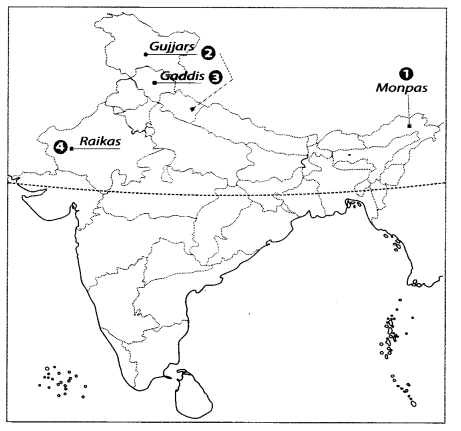
Q2. Features are marked by numbers in the given political outline map of India. Identify these features with the help of the following information and write their correct names on the lines marked on the map.
1 A pastoralist community
2 A pastoralist community
3 A pastoralist community
Answer:
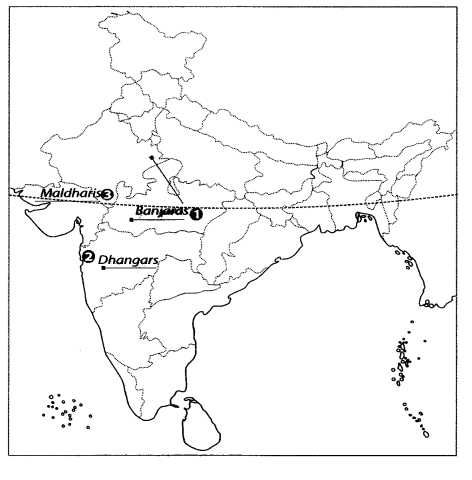
Q3. Features are marked by numbers in the given political map of India. Identify these features with the help of the following information and write their correct names on the lines marked on the map.
1 A pastoralist community
2 A pastoralist community
3 A pastoralist community
Answer:
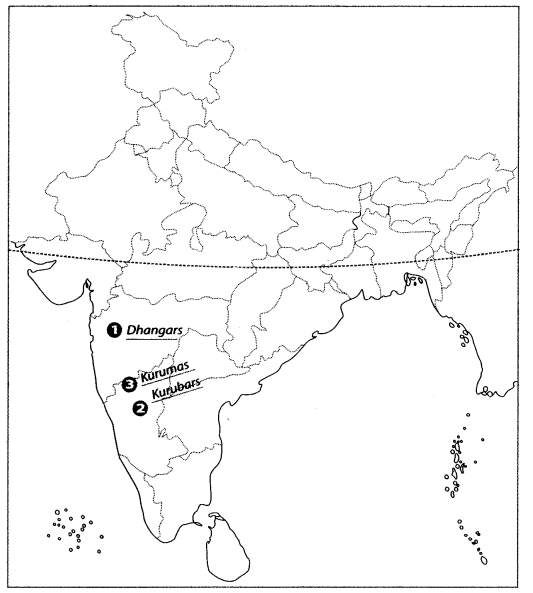
Africa
This map shows the distribution of pastoralists in Africa.
Q4. Locate and label the following items on the given map with appropriate symbols.
1 Herero
2 Berbers
3 Bedouin
4 Beja
Answer:
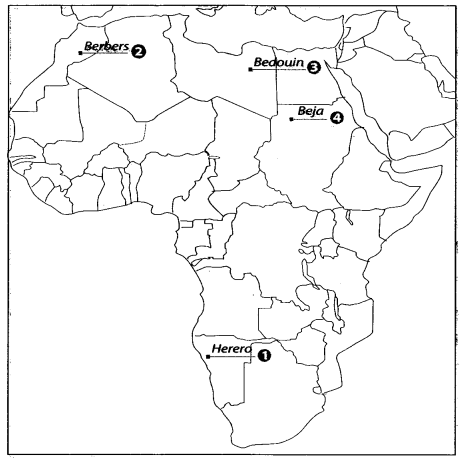
Q5. On the given outline map of Africa. Identify the pastoralist groups which are found at the locations marked 1, 2, 3.
Answer:
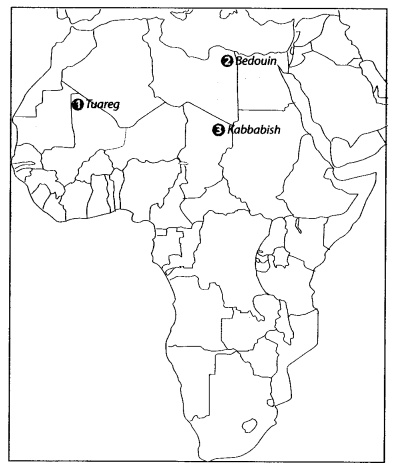
Q6. Locate and label the following items on the given map with appropriate symbols.
1 Maasai
2 Danakil
3 Wodaabe-Fulani
Answer:
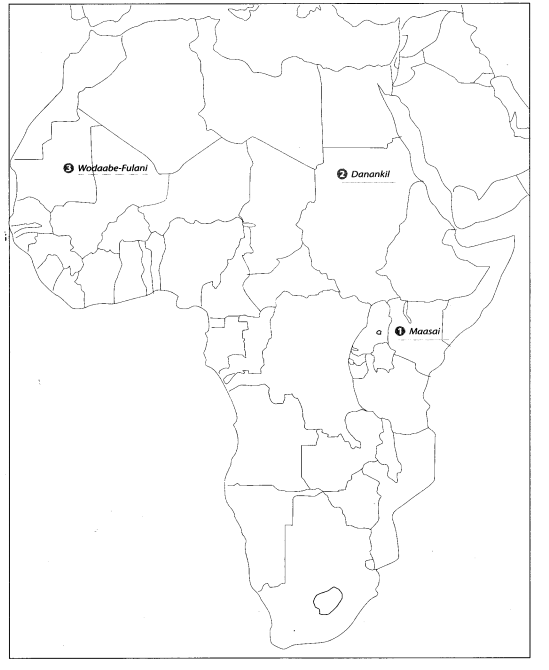
Conclusion
We have penned down the short and detailed notes Pastoralists In The Modern World Class 9th Social Science along with the NCERT solutions and map skills. Students would be able to get the gist of the lesson Pastoralists In The Modern World Class 9th Social Science to make their concepts clear before their examinations.

